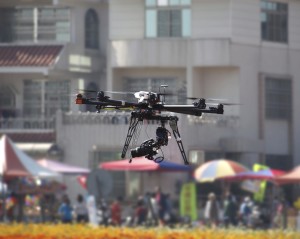
Scholar offers approach to surveillance technologies based on Fourth Amendment principles.
Half of American adults—more than 117 million people—have identifying information recorded in law enforcement facial recognition databases.
Other pervasive surveillance technologies include mass surveillance drones, digital location tracking, and “predictive policing,” which aggregates and analyzes crime data to predict future crimes.
How might society determine the appropriate roles for these technologies that balance their beneficial uses with accompanying harms? In a recent article, Andrew Guthrie Ferguson, a professor of law at the American University Washington College of Law, offers an approach to regulating new surveillance technologies based on Fourth Amendment principles.
Ferguson seeks to “reset the starting point for the debate on policing technologies.” He groups past approaches to policing technologies into three categories: the trust lens; the trap lens; and the technocratic lens. Finding them all lacking, he advocates a new approach—the tyrant lens, which assesses new technologies under a legal framework of checks and balances borrowed from the Fourth Amendment.
The trust lens—as the name says—trusts law enforcement to use surveillance technology responsibly and effectively. Ferguson labels this as the standard operating assumption for much of the last century. He argues that use of surveillance technology by police departments remains “mostly unregulated, unfettered, and unexamined” even amid larger institutional criticisms.
Absolute trust in law enforcement, however, contributes to over-policing and discriminatory enforcement and imperils constitutional rights to privacy and free association, according to Ferguson. For example, the Los Angeles Police Department (LAPD) initiated a predictive policing strategy called the Los Angeles Strategic Extraction and Restoration (LASER) program. LAPD designed LASER to collect information on criminal groups and violent offenders and invested in “a host of digital tracking technologies.” The program operated without any regulatory constraints, and Ferguson argues that LAPD pursued its mission autonomously and independently overall.
The LASER program received intense public backlash, which led to an audit by the LAPD Inspector General. The audit revealed that the LASER program “encouraged unconstitutional stops, had few rules, no training protocols, and reified existing racial disparities.”
On the other side of the philosophical spectrum from the trust lens is the trap lens. Ferguson describes the trap lens as an abolitionist approach that absolutely distrusts law enforcement’s use of surveillance technology. He explains that, considering the historical track record, surveillance technology is often viewed as a trap to exert political, cultural, and economic oppression over minority groups.
The trap lens is intellectually consistent and advocates for unambiguous policy, which can provide a mobilizing force for reform, Ferguson explains. For example, community leaders in Boston, Massachusetts successfully pushed the city council to pass an outright ban on facial recognition technology. Ferguson counts this as one “of the clearest legislative wins on any surveillance technology anywhere.”
Still, the ultimate result of the trap lens—a complete regulatory ban on all surveillance technology—is neither desirable nor feasible, argues Ferguson. So long as crime exists, there needs to be a response to crime, and surveillance technologies play a necessary role in that response.
Ferguson argues that between absolute trust and absolute distrust is a third approach—the technocratic lens— which he describes as a pragmatic middle-ground that “emphasizes democratic accountability, external transparency, and internal front-end evaluations to cabin the use of new policing technologies.”
The best example of the technocratic approach, Ferguson suggests, is the adoption of Community Control of Police Surveillance (CCOPS) ordinances by several cities. The American Civil Liberties Union (ACLU) drafted CCOPS as a model bill to provide localities more insight into and control over law enforcement’s use of surveillance technology. Among other things, the legislation requires “surveillance impact reports, use policies, annual audits, public hearings, and whistleblower protections.”
Although Ferguson says that the technocratic approach offers improvements over the trust and trap lenses, he also argues that it suffers from many administrative and enforcement problems. First, it takes considerable time, energy, and money to create impact reports, draft policies, and conduct hearings and audits. Second, the penalties for failing to follow the policies are limited. Ferguson argues the technocratic approach “shows gains in transparency but not necessarily a limitation on police power.”
Given the insufficiencies of these three approaches, Ferguson advocates for an alternative: the tyrant lens. The tyrant lens draws on Fourth Amendment principles and considers surveillance technologies with reference to the metaphorical threat of tyrannical power. The tyrant lens also offers a middle-ground between the trust lens and trap lens, but it focuses on power, unlike the technocratic lens, which focuses on plans and policy.
Following this approach, Ferguson proposes the “tyrant test” as “a first principles framing-theory” for assessing new surveillance technologies. The tyrant test focuses on structural protections and substantive limitations to reduce the threat of tyrannical abuse.
As a structural matter, the Fourth Amendment limits legislative and executive authority over government searches and seizures. It forces judicial involvement by requiring a neutral magistrate to sign a search warrant based on probable cause when a person’s property or privacy interest is affected.
To pass the tyrant test, any new surveillance technologies must “establish these structural checks on power.” For example, the government would need to secure a search warrant before searching a facial recognition database. Ferguson notes that investigators also follow this approach in other instances, such as when requesting cell site location information from carriers.
As a substantive matter, the Fourth Amendment originally barred certain private areas from government monitoring. Private papers understood as “physical manifestations of the author’s thoughts” remained in a zone of privacy that the government could not intrude. Ferguson suggests that certain digital information, such as data pulled from smart home devices, should also fit into this zone of privacy.
In the end, Ferguson proposes the tyrant test as a starting point and framework for constructive regulatory debate about the “future power balance between the police and the people.”



